Intro
As the temperatures continue to drop in the northern hemisphere, many of us are thinking about and adapting our layering setups. Whether it’s for skiing, biking, running, or any other activity, an ideal combination of base, mid, and outer layers can make your time outdoors a whole lot more — or less — enjoyable.
Midlayers are a vital part of this, especially when it comes to balancing cold temperatures with high-output activities. As we’ve discussed in our Layering 101 article, we’ve now got a greater variety of layers to pick from than ever before, which is great in terms of having options, but it also means narrowing down all of them becomes trickier.
In this roundup, a bunch of our reviewers discuss a number of midlayers that they’ve been using over the past couple of years, outlining how each one stands out, what it does best, and where it might make sense to go with something else.
We’ve added several additional pieces since we first posted this and will continue to update once we’ve spent more time with some more pieces we’re currently testing, so stay tuned for updates.
7mesh Chilco Anorak
MSRP: $200
Fabric: 57% Polyester, 34% Recycled Polyester, 9% Elastane
Insulation: 57% Polyester, 34% Recycled Polyester, 9% Elastane
Size Tested: Medium
Reviewer: 6’, 170 lb / 183 cm, 77.1 kg
David Golay: The Chilco Anorak is 7mesh’s take on an active midlayer that combines lofted grid insulation on the inside of the jacket with a tighter-woven, somewhat wind- and water-resistant face fabric — a similar concept to the Patagonia R1, Outdoor Research Ascendant (RIP), and others. 7mesh developed their own fabric (which they’ve dubbed “WTV”, for “Wind, Thermal, Ventilation”) for the application, and what sets it apart from other styles I’ve tried (most notably the Outdoor Research Ascendant) is that the Chilco is notably thicker and warmer, but still breathes reasonably well. I’ve only tried on (but not worn in earnest) the Patagonia R1 and R2 but my hunch is that the Chilco essentially falls between the non-Techface versions of those two on the warmth spectrum.
7mesh describes the Chilco as being designed with a relaxed fit, and I’d generally agree, but it’s not wildly roomy or anything like that.
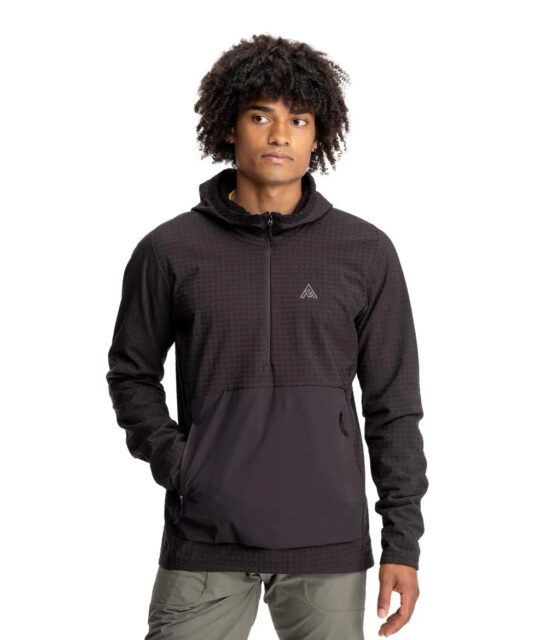
I’ve worn the Chilco over a T-shirt and flannel a whole bunch for casual use, as well as over a lighter baselayer on the bike; it fits me nicely for both. The inner, insulated side of the WTV fabric is extremely soft and comfortable and the fabric strikes a nice balance between insulation, breathability, and moderate wind resistance for a variety of active pursuits. For me, personally, the Chilco is just a little bit too warm to wear on the bike in temperatures above about 40° F or so, but it’s been great for cooler rides and general casual wear, and I’m quite confident that I’ll like it as a ski-touring midlayer once I start getting out on snow (soon!).
The Chilco’s sleeves are moderately long but do a nice job of gathering at the wrists without unduly bunching up. The cuffs are non-adjustable but feature a tapered stretchy panel to keep the openings from billowing open, while still being easy to take on and off. 7mesh describes the hood as compatible with and without a helmet, but for me, personally, it’s great for the former but a little small for the latter (granted, I wear a larger size helmet than I do a jacket, and it does still work in a pinch).
I’ve mostly remained neutral in the Blister Anorak Wars, but I’m happy with the layout of the Chilco and have appreciated the giant dual-zippered pass-through pocket that the Anorak form factor permits, particularly for things like storing gloves when I’m putting them on and off somewhat regularly in an effort to regulate temperature. 7mesh also offers a Chilco vest, as well as a slimmer-fitting, more road / gravel-oriented full-zip jacket and vest (the Seton) in the same WTV fabric, all of which are available in both men’s and women’s versions.
Outdoor Research Shadow Insulated Hoodie
MSRP: $219
Fabric: 20D Stretch Woven Shell and Lining (90% Nylon, 10% Spandex)
Insulation: VerticalX™ ECO SR Insulation (55% Repreve® Recycled Polyester, 35% Sorona®, 10% Polyester)
Size Tested: Medium
Reviewer: 5’9”, 167 lbs / 175 cm, 75.7 kg
Kara Williard: I first wrote about the Shadow Insulated Hoodie in Stuff We Like: October 2021. Not much has changed since then, except I have put the durability of the hoodie to the test and have used it for a lot of different applications. It has proven to be a packable layer for bikepacking, camping, hiking, and more. The Shadow Insulated Hoodie is quite warm and insulative, while still being lightweight and packable. It’s built with Outdoor Research’s most breathable and packable insulation, and I was impressed with how compact it is while also still feeling warm enough to be my outer layer on shoulder-season bike rides.
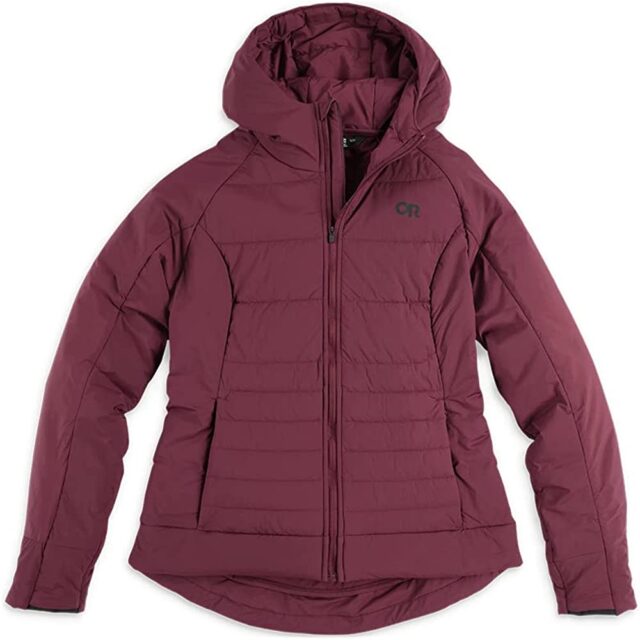
The face fabric is wind and water resistant, but it is comfortably breathable, which says a lot since I avoid insulation most of the time while on the bike. The Shadow Hoodie works great for blocking the wind and keeping warm even after the sun sets. The fabric is super cozy and soft, and the insulation is thin and lightweight, which keeps it comfortable even during sustained movement.
The Shadow Hoodie features two zippered hip pockets and two inner stash pockets, all of which hold my phone and other phone-sized objects. So far, the Shadow Hoodie is the layer I have tested the most in terms of durability, and it has proven snag-resistant.
A Women’s Medium fits what I consider to be pretty much perfectly for a midlayer (at least for me). The sleeves are long but not bulky at the wrists, and the thumb loops feel comfortable with my arms outstretched. The length across the torso also fits a bit long, which benefits my height, and it doesn’t feel constricting in any way, since the material is quite stretchy. The Shadow Hoodie is roomy enough to fit a couple layers underneath, and best yet, the hood is roomy enough to still feel comfortable even when zipped all the way over a couple of layers and a hat. As far as packability, the Shadow Insulated Hoodie packs into itself and stows easily on my handlebar bag.

Flylow Mia Jacket
MSRP: $280
Fabric: Pertex Quantum Air (100% polyamide), Furano Fleece side panels (94% polyester, 6% spandex)
Insulation: 80g Greenloft recycled insulation
Size Tested: Medium
Reviewer: 5’9”, 167 lbs / 175 cm, 75.7 kg
Kara: The Flylow Mia Jacket has evolved into a new favorite of mine. It offers quite a bit in terms of warmth and insulation, yet it’s also quite breathable. I favor the Mia Jacket as both an outer layer for casual wear and also as a pretty versatile midlayer that errs on the warmer side.
The body of the Mia jacket has a durable finish. This durability is a plus when it comes to having a layer that feels substantial enough to use as an outer layer for activities such as ski touring and camping. The Mia also feels a bit more protective against wind than many midlayers here, which is kind of nice for occasions when I don’t necessarily want to commit to an additional hardshell layer.
The Mia jacket is built with two pretty large zippered hip pockets that offer quite a bit of room, in addition to two internal stuff pockets that are pretty large and wide open, perfect for stashing something quickly.
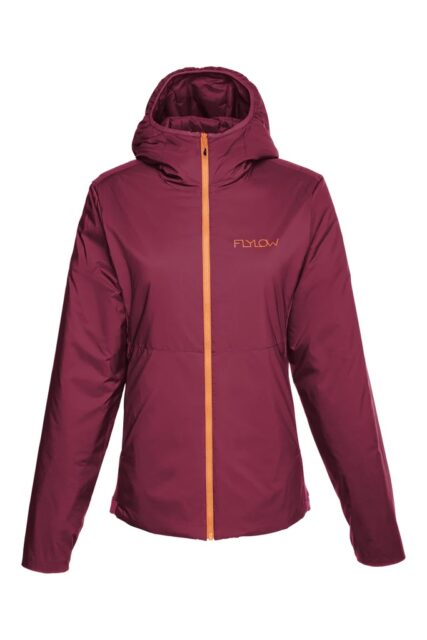
I tested the Mia in a Women’s Medium and was not surprised to find that it offered plenty of length in the torso and sleeves. Flylow is a great fit for my taller frame and torso, and this holds true for the Mia Jacket. The Medium is a bit more spacious than a Medium in the Eddie Bauer EverTherm, but pretty similar to the Outdoor Research Shadow Hoodie, albeit cut slightly longer. The Mia’s hood is also pretty roomy and provides good coverage, and it feels quite comfortable fully zipped up, even when dealing with multiple layers.
The Mia Jacket provides a bit more warmth than the Eddie Bauer EverTherm, but is similar to the Shadow Hoodie in terms of warmth and insulation thickness. The Mia works great as a jacket for everyday wear when temperatures aren’t terribly cold, and because it’s on the warmer side while still being fairly breathable, comfortable, and versatile, it’s what I chose as a midlayer for my trip to Antarctica this November.
Eddie Bauer EverTherm Downdraft Hooded Jacket
MSRP: $349 (currently on sale for $261.75)
Fabric: 100% Nylon with DWR Finish
Insulation: 30g Responsible Down Standard (RDS) Thindown®
Size Tested: Medium
Reviewer: 5’9”, 167 lbs / 175 cm, 75.7 kg
Kara: The Eddie Bauer EverTherm Downdraft Jacket shares some similarities with the Outdoor Research Shadow Insulated Hoodie; however, the EverTherm Downdraft weighs less and is quite a bit more packable, though not as warm.
The EverTherm Downdraft became a favorite of mine for warmer ski tours, slightly warmer but still windy days on the resort, and for getting around town when I just need a little insulation to keep some heat in. It’s a pretty thin, minimal midlayer that offers a versatile amount of warmth for those who run on the hotter side, though it’s best paired with a more weather-resistant outer shell when the wind or precipitation ramps up.
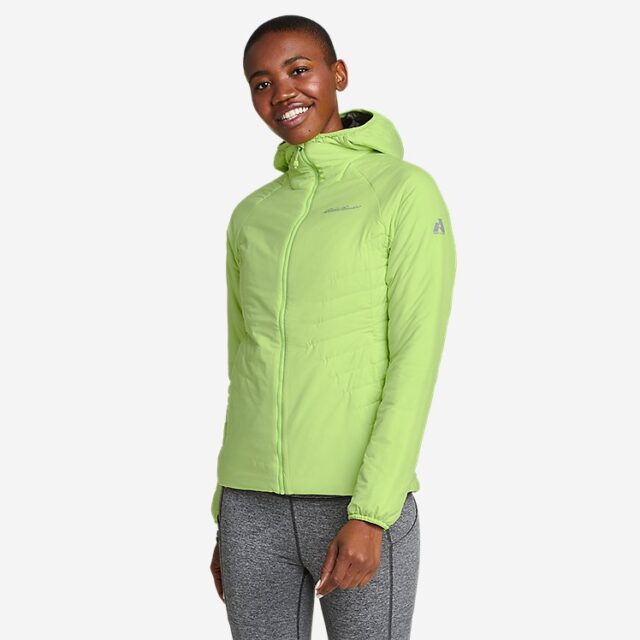
However, if you’re looking to use a midlayer for high-intensity activities, something with a more breathable synthetic insulation will likely be a better choice. The nylon / down composition of the EverTherm didn’t dry very well when I started to perspire, which left me feeling a bit cold when transitioning for a descent.
The EverTherm has two zippered hip pockets that are slightly smaller than either the Shadow Hoody or Mia Jacket, but still big enough to hold my phone. So far, the EverTherm has held up durability-wise, but with the soft finish on the outer material and some pretty thin, minimalistic zippers, I am curious how it will age over time.
The EverTherm Downdraft jacket runs quite a bit smaller than the Outdoor Research Shadow Insulated Hoodie. Not only is the EverTherm a little shorter, but it’s also a bit snugger, too. This works well in regards to layering, and it’s one of the few insulated midlayers I can comfortably wear beneath my ski bibs, but you may want something roomier (and/or warmer) if you plan on frequently using it as an outer layer.
OutdoorVitals Ventus Active Hoodie
MSRP: $180
Fabric: Shell Fabric: 20D Ripstop Nylon DWR treated
Insulation: 3DeFX
Size Tested: Medium
Reviewer: 5’9”, 167 lbs / 175 cm, 75.7 kg
Kara: Several of our reviewers have talked about the Ventus Active Hoodie in our monthly Stuff We Like series, and I talked about it in the August 2022 edition. As far as lightweight yet insulated layers go, the Ventus Active Hoodie definitely stands out.
I found the Ventus Active Hoodie to be one of the better options for when I need something breathable but the temperatures are cold enough to justify some extra insulation beyond just baselayers. It also serves as a good just-in-case insulation layer, since it doesn’t take up much space (though it’s also not super warm). The Ventus uses Outdoor Vitals’ “3DeFX Insulation” with a ripstop nylon face fabric. The insulation material is coiled, which OutdoorVitals states will expand to help with breathability. Overall, I can vouch that the Ventus Active Hoodie is both breathable and quite durable.
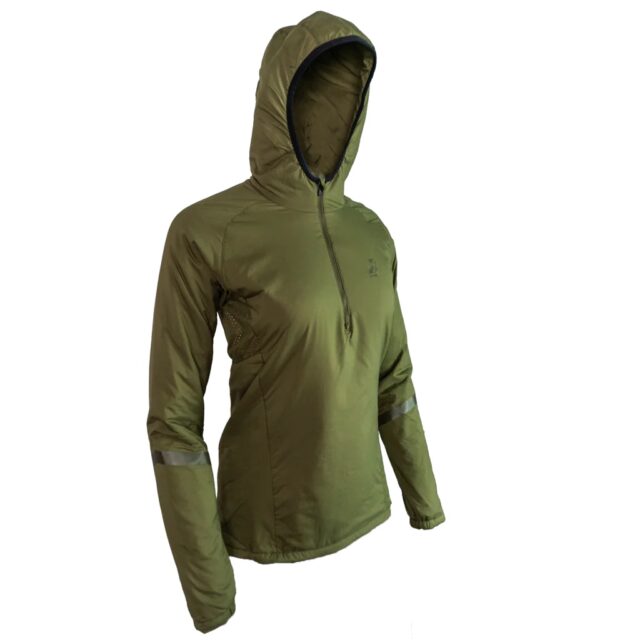
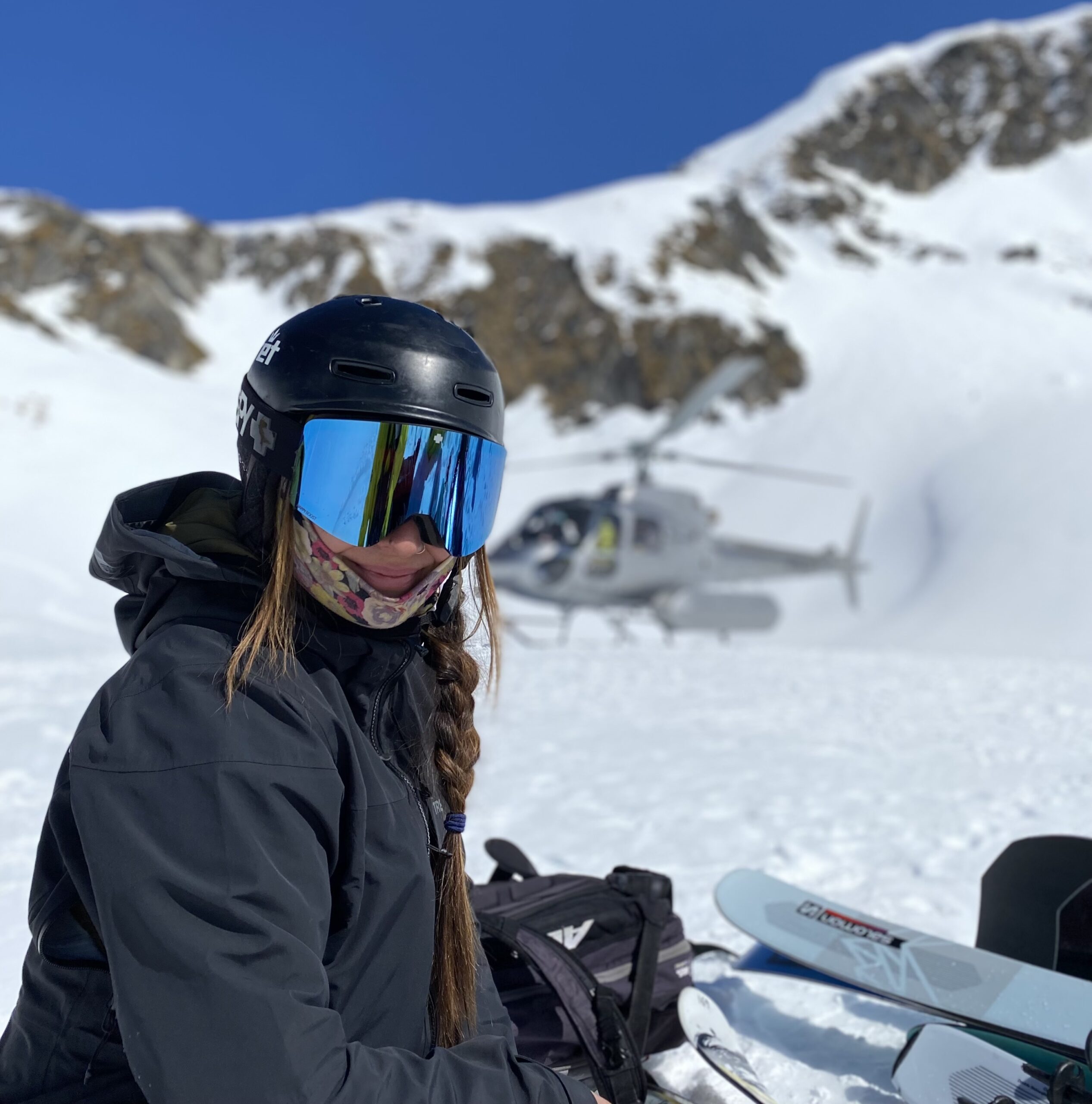
The other day, I accidentally wore mine into my chicken coop, and when it snagged on a fence wire, its fabric (surprisingly, given how light it is) remained intact.
Better yet, the Ventus Active Hoodie’s material is stretchy, easy to move in, and provides good ventilation, particularly under the arms. It’s a ¾ zip, so unzipping at the neck is another way to further enhance breathability. I would typically prefer a full zipper on a midlayer, but in the case of the Ventus, I found it easy to take on and off — and it’s above-average breathability means that I don’t feel the need to take it off as often as warmer alternatives.
The Women’s Medium is comfortable, even with a thicker jersey or baselayer underneath, and I found the length in the torso and the arms to fit just right. Overall, this has been one of the only insulated jackets that I can tolerate wearing while being really active (on a bike, especially); it’s breathable, yet still provides a little extra warmth in a way that allows me to easily regulate my body temperature while exercising. For those looking for an ultralight jacket to throw in your layering system when you don’t need or want a ton of warmth, I would recommend checking out the OutdoorVitals Ventus Active Hoodie.
Velocio Women’s Alpha Long Sleeve
MSRP: $199
Fabric: 80% Polyester (63% recycled) / 20% Merino Wool
Size Tested: Large
Reviewer: 5’9”, 167 lbs / 175 cm, 75.7 kg
Kara: Moving away from some puffy-insulation options that can be used with or without a shell, the fleece Velocio Alpha Long Sleeve is, by definition, a midlayer — it is intended to be worn with a windproof shell on top.
The mixture of its Polartec Alpha Direct Insulation and panels of merino wool along the sleeves and down the back combine to offer both warmth and tons of breathability. It’s also a low-profile and highly packable layer, making it a great option to bring along on the bike. The material is super soft and cozy, and the fabric is quite stretchy and provides a good range of motion, particularly when on the move.
As I have found with several Velocio pieces, they run a bit small and certainly favor a close, snug fit. For this reason, the size Large is a more comfortable fit for me, especially when wearing layers underneath.
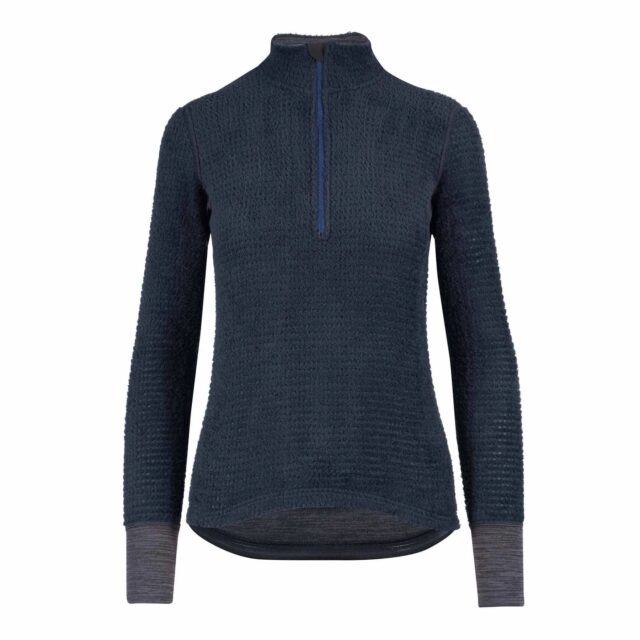
This type of super-breathable midlayer has been great for fall / winter biking and ski touring. It’s definitely best to wear a shell on top in really cold (and/or windy) weather, but when you need a quick cool-down or lots of breathability, the Alpha Long Sleeve is a good option. It fits closer to something like a thick, warm bike jersey than a bulkier midlayer, which also makes it a good choice as an extra layer between a baselayer and a thicker midlayer (when you really need to layer up). The ¾ zip also works well for providing even more breathability. Both of the materials are quite stretchy and very soft. There are also a couple of features that make the Alpha feel more like a warm, fuzzy bike jersey than a do-anything layer (namely the three back jersey pockets and its really slim, athletic fit).
Overall, I prefer this midlayer for biking more than I do for skiing, but it could make sense for backcountry skiing, especially if you prioritize breathability and a slim fit over warmth and weather resistance.
Norrona Women’s Falketind Alpha120 Zip Hood
MSRP: $209
Fabric: Polartec Power Grid (50% synthetic recycled fiber) & Polartec Alpha
Size Tested: Large
Reviewer: 5’9”, 167 lbs / 175 cm, 75.7 kg
Kara: The Norrona Falketind Alpha120 is one of my favorite non-puffy midlayers to date. It’s an excellent balance of warmth, breathability, and comfort. Similar to the Velocio Alpha, it utilizes a classic waffle-grid fleece pattern, but with a mix of fuzzy, open-knit Polartec Alpha and denser-knit Polartec Power Grid. It’s definitely the layer I opt for on colder days when I know I will be working up a sweat, or when I’m really weary of overheating (as can easily happen with some of the warmer, puffy-insulated pieces we’ve mentioned above).
The Falketind is soft, stretchy, and easy to move in. After going back and forth between sizes, I ended up with a Women’s Large.
Overall, the Large offers a comfortable, roomy fit for me, and is ideal for wearing a couple of baselayers underneath. However, the extra material also feels a little loose, making it more difficult to layer beneath a bib.
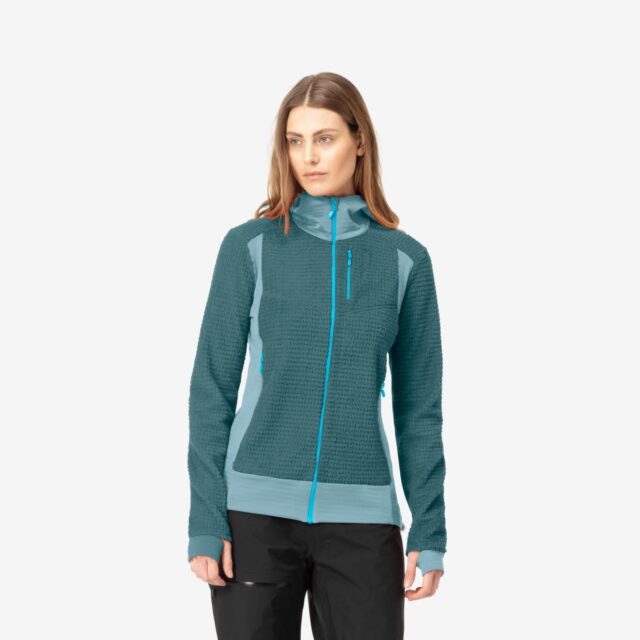
The Falketind is built with two zippered pockets situated a little higher than my hips. This makes it more compatible while a harness, which is one reason I’ve opted to bring it with me on an upcoming trip with some glacier travel.
Overall, the weight, packability, and breathability of the Norrona Falketind make it a highly versatile layer that can be used for a lot of activities, whether biking, skiing, climbing, or hiking. I found myself reaching for it often, especially on ski days when I wanted just a little added warmth without seriously compromising the breathability of my layering system.
Flylow Katinka Hoody
MSRP: $145
Fabric:
- Furano Fleece: 94% polyester, 6% spandex
- Taffeta 100% polyester
Size Tested: Medium
Reviewer: 5’9”, 167 lbs / 175 cm, 75.7 kg
Kara: The Flylow Katinka Hoody is another great grid-fleece midlayer that offers a lot of versatility. Built from Flylow’s “Furano Fleece,” it has a smooth outer fabric with grid-fleece inside. It’s also finished with DWR, making it a bit more protective on its own than other fleece midlayers here (especially the 2 above).
I find the Norrona Falketind and Velocio Alpha to be a bit more breathable, especially during high levels of activity, but the Katinka is a favorite of mine for cold resort laps, or when I want a little extra protection and warmth (especially against the wind) while going up the skin track, but a puffy midlayer will be too much. It also just works well for other activities, such as hiking or climbing. The material is stretchy and provides a great range of motion, but the DWR finish also provides an extra level of protection against light precipitation.
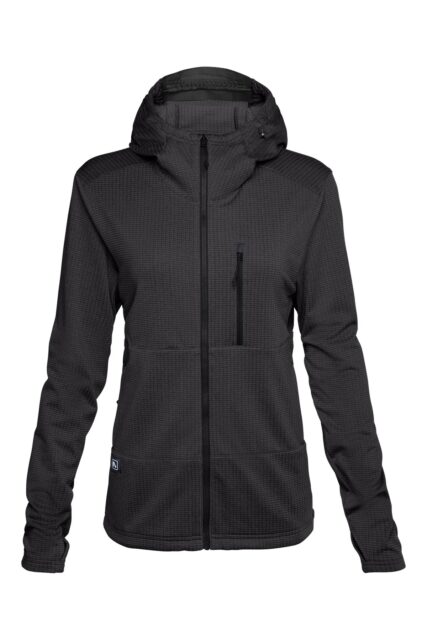
The Katinka features two zippered hip pockets and one zippered chest pocket. The hip pockets are pretty large and work well for a phone.
I’d say the fit is average for Flylow, which is typically a little longer and taller than most other brands; consequently, a Medium works well for me. I especially appreciate that the sleeves are a little longer than some of the other layers listed above. The zip closure right at my waist is a little snug, but this actually works well to prevent the layer from riding up or shifting around beneath my bib and backpack. While the Katinka has proven durable so far, it has gotten a little pilly in the areas that get a lot of rub and wear, such as the sleeves. It’s not too big of a deal, but compared with some of the other layers above, I did notice this a bit earlier in the Katinka.
The Katinka is a great layer if you aren’t looking for something overly warm or insulated but you still want a little more protection against the elements without having to wear a shell on top.
Arc’teryx Atom LT Hoody
MSRP: $259
Fabric:
- Tyono 20 denier with DWR coating (100% nylon)
- Dope Permeair 20 on sidebody (100% recycled polyester)
Insulation:
- Coreloft 60g (100% polyester)
- Stretch fleece (94% polyester, 6% elastane)
Size Tested: Medium
Reviewer: 5’11”, 165 lbs / 180 cm, 75 kg
Drew: As a well documented bum who salivates over multi-use anything, midlayers are something I inherently appreciate. And the Atom LT Hoody from Arc’teryx is perhaps the most versatile of the midayers I own, so it gets the most use.
The Atom LT is the least warm of my midlayer entries here — just less so than the Patagonia Nano Air — which makes it ideal for summer and fall forays into the alpine as well as winter ski touring.
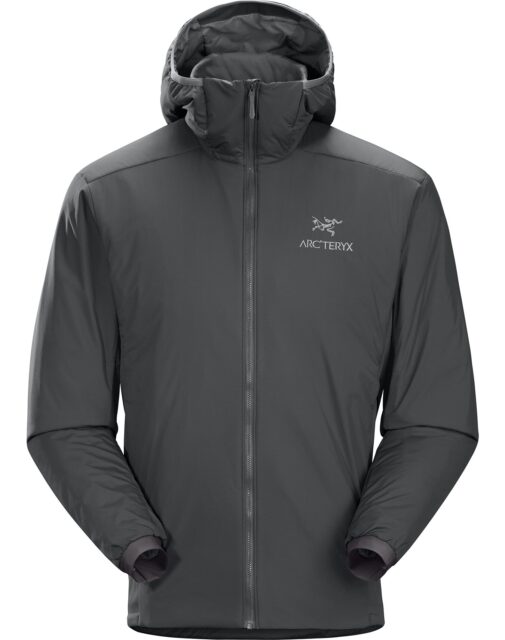
Anything warmer causes me to overheat. The connective tissue that brings together the Atom LT’s perfect balance between warmth and breathability across all seasons is its strategically targeted insulation and wind-resistant material, with less dense, more breathable insulation placed under the arms, forearms, and sides. Add just enough water resistance from the DWR coating to stave off light precipitation, and this piece has become my alpine workhorse — in fact, I value it so much I had the full front zipper replaced when it gave out at the excellent Function Before Fashion, located here in Crested Butte, Colorado.
Beyond being utilitarian, the Atom LT hoody is just really comfortable. It is unrestrictive in its stretchiness, the fabric is comfortable — especially in the smooth and wide cuff bands — and the whole piece feels very airy and svelte. Two front hand-sized pockets and an interior chest pocket great for a phone round out the Atom LT.
And while synthetic insulation is occasionally divisive, I have found that the Atom LT has been more durable, easier to clean, and maintained its insulation better than most of the down pieces I own.
Luke Koppa: I’m also a major Atom LT fan. This past spring, winter, and fall, I wore mine almost every day, in large part because I frankly just think it looks really good and it’s super comfortable (and I tend to keep my house pretty cold…). As an apparel nerd, I think the Atom LT Hoody is one of the best designed pieces I’ve ever used, in terms of both form and function.
I agree with much of what Drew said above. This is a very versatile piece, and it was one of the first to lead the way when it comes to more breathable puffy insulators. The latest version that I have uses a slightly different stretch-ripstop face fabric that’s just as comfortable as the original taffeta, but I’ve found it to be slightly more abrasion resistant.
I tend to run hotter than most, so I rarely wear a puffy midlayer — even a breathable one like this — while huffing and puffing uphill on a skin track or even a steep hike. (That’s also the main reason I don’t seem to ever have an image of me in just a midlayer…) But I’d say the Atom LT sits slightly on the more breathable side of the spectrum in terms of the sort of standard midlayer category (for synthetic jackets, that’s typically 60-g insulation). It’s a bit more breathable than the Patagonia Nano-Air, but not as airy as the more minimal options, such as the Arc’teryx Proton FL or the old Patagonia Nano-Air Light Hoody. But the Atom LT offers more warmth and weather protection than those pieces, so it’s a bit more versatile when used without a shell. It’s also held up well to tons of washing and drying (on low temp), and like Drew, I plan on keeping mine in functional shape for as long as possible.
Patagonia Nano-Air Jacket
MSRP: $249
Fabric: 100% polyester (87% recycled), DWR coating (PFC free)
Insulation: FullRange 60g (100% polyester, 40% recycled)
Size Tested: Medium
Reviewer: 5’11”, 165 lbs / 180 cm, 75 kg
Drew: The Nano Air jacket is perhaps Patagonia’s competitor to the Arc’teryx Atom LT. It’s an active insulation piece that is warm for its weight and size, breathes well, and provides a small amount of protection from wind and precipitation.
In direct comparison to the Atom LT jacket, the Nano-Air is a good bit warmer and more comfortable, but is slightly bulkier. It does not breathe as well, or offer quite as much wind protection as the Atom LT. As a result, I tend to rarely use it for consistent high-output activities like alpine scrambling or ski touring — every time I have, I end up overheating pretty quickly, but being cold when snacking or transitioning between walking and skiing. Instead, I often wear the Nano Air for resort skiing, layering it under a shell jacket; or I’ll bring it Fall hiking, climbing, and camping. For those applications, I seem to stay pretty comfortably warm.
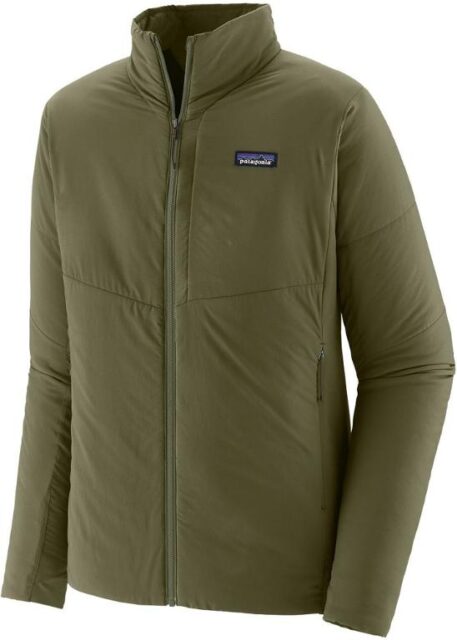
After moderately using this layer for the past five years, my initial worries about the durability of the soft and stretchy face fabric and thin elasticized cuffs have gone away. My only qualms are that I find the sizing to run large, and the cut is pretty boxy.
Luke: The Nano-Air has been my go-to resort-skiing midlayer for a few years now. Like Drew, I find it to be a bit too warm for backcountry skiing, but for me, that’s also the case for the vast majority of puffy midlayers (even breathable ‘active’ ones like the Nano-Air). However, what I like about the Nano-Air for resort skiing is that it still gives you more temperature-range versatility than a traditional, non-breathable synthetic or down puffy, while offering a very similar level of warmth under a shell. So I can happily wear it in the resort throughout almost the entirety of a season, apart from really warm spring days. As far as fit goes, I agree that it’s slightly boxy, but I wouldn’t say it runs very large — the size Medium Nano-Air fits very similarly to most other size Medium midlayers I’ve used.
Compared to the Atom LT, I agree with Drew in that the Nano-Air is a bit warmer and less breathable (not to a huge degree, in my experience), though I don’t find it notably less wind resistant (particularly if there’s a cross wind, which can slice through the Atom LT’s fleece underarm panels). I do think the Atom LT just looks a lot better, though.
I’ve put well over a hundred days in mine, and it’s held up quite well. Granted, I don’t use it very often as an outer layer, and its face fabric is not what I’d pick for frequent brushes with grabby tree branches and the like. But it’s still my current favorite midlayer for resort skiing in most winter temperatures, and for other moderate-output activities.
Ibex Wool Aire Hoodie
MSRP: $285
Fabric: 20 denier nylon
Insulation: 80g, 80% merino wool, 20% polyester
Size Tested: Men’s Medium
Reviewer: 6’2”, 160 lbs / 187 cm, 73 kg
Blister’s Measured Weight: 323 g
Jed Doane: Most midlayers on this page are composed of down or synthetic insulation, as has been the industry standard for decades. Ibex’s Wool Aire Hoodie is decidedly different, and is a great option among active insulators.
The Wool Aire Hoodie utilizes a proprietary merino wool insulation and has become my go-to active insulator while touring. Despite being extremely lightweight, it features zippered chest and handwarmer pockets while saving weight with elastic cuffs, hem, and hood. After seven months of constant use, the 20-denier face fabric has held up well with only minimal damage — it’s not the most durable piece, but it hasn’t shown wear from pack straps or the occasional errant splitboard edge.
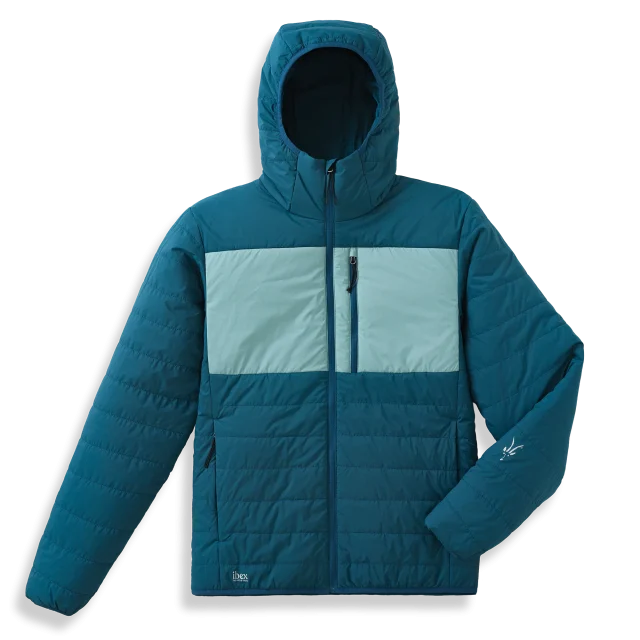
I’ve been very impressed by the merino wool insulation, finding it to be incredibly breathable and easy to move in, and the 80-g fill is a great weight for me to use for active winter pursuits and casual use in the shoulder seasons. It’s also more packable for the weight than other active insulators I’ve used. On the coldest winter days, I’ll layer on another light down jacket for transitions or lunch, but have found it to be a versatile insulator overall. It’s stayed remarkably stink-free through the months and has survived several careful trips through the washing machine without incident. The fit could generally be described as slim and long, though the generous stretch in the fabrics would likely allow for a comfortable fit with a variety of body shapes.
Rab Microlight Alpine Down Jacket
MSRP: $279.95
Fabric: Pertex Quantum 30 denier / 20 denier with DWR finish
Insulation: 700 fill hydrophobic down, Responsible Down Standard certified
Size Tested: Medium
Reviewer: 5’11”, 165 lbs / 180 cm, 75 kg
Drew: A lot of people are pretty vocal about loving down, so I feel like a bit of an outlier when I say I really only appreciate down in the specific circumstance of needing a really warm layer that also needs to be exceptionally packable. Otherwise, I find it smells quickly, often uses delicate face fabric that can result in a catastrophe when it inevitably tears, is a pain to wash and dry, and seems to break down more quickly over time than synthetic insulations (or at least, is harder to keep from breaking down; care is super important there). Not to mention how sensitive even hydrophobic downs can be to wetting through and clumping (which renders the down basically non-functional).
All that said, the Rab Microlight Alpine Down Jacket has been an excellent tool in the right scenarios.
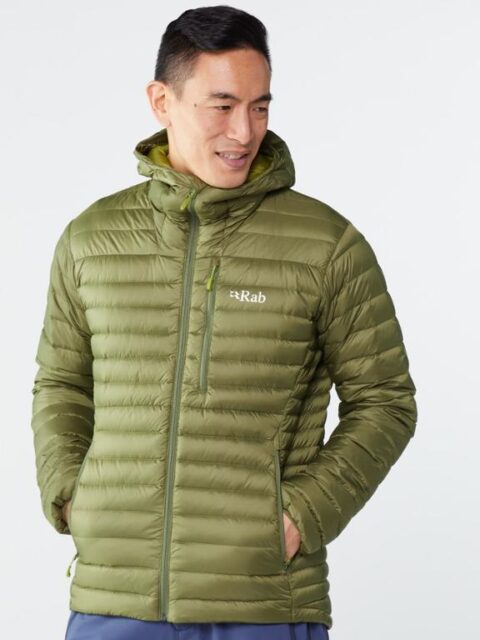
It features high-quality 700-fill-power down, which means lots of loft / warmth for little bulk, and the face fabric has been durable enough to withstand the rigors of ski touring and mountaineering (mainly used as a midlayer, not as often as an outer one).
The cut of the Microlight Alpine Down Jacket is what makes this jacket stand out. The lower midsection is slim and just slightly long, which keeps the jacket from being bulky while preventing it from riding up. The chest and shoulder areas feel just a bit more generously cut than the rest of the jacket, which allows for mobility.
Other than that, it’s pretty simple: there are two well-sized front hand pockets and a fairly large chest pocket, a hood that fits over a helmet, and a softer, thinner nylon interior fabric that keeps friction against other layers low. More breathable pieces like the Atom LT are better for keeping on while working up a sweat, but the Microlight Alpine Down Jacket is what I pick when I need some added warmth while relatively stationary, and pack space is limited.
PART TWO
Patagonia Micro Puff Hoody
MSRP: $329
Fabric: Pertex Quantum (10D NetPlus 100% postconsumer recycled nylon ripstop)
Insulation: 65-g PlumaFill (100% recycled polyester)
Size Tested: Men’s Medium
Reviewer: 5’8”, 155 lbs / 173 cm, 70 kg
Luke Koppa: When I first heard about the claims Patagonia was making about their new PlumaFill insulation when they announced it back in 2018, I was very skeptical. But as we found, they had reason to talk a big game — their synthetic PlumaFill insulation is the best we’ve ever used in terms of replicating down’s warmth-to-weight ratio.
The original Micro Puff was the first piece to feature that insulation, and it’s still an excellent option for those who want to optimize packability, low weight, and decent warmth — without worrying about getting their midlayer wet and it losing its insulative value.
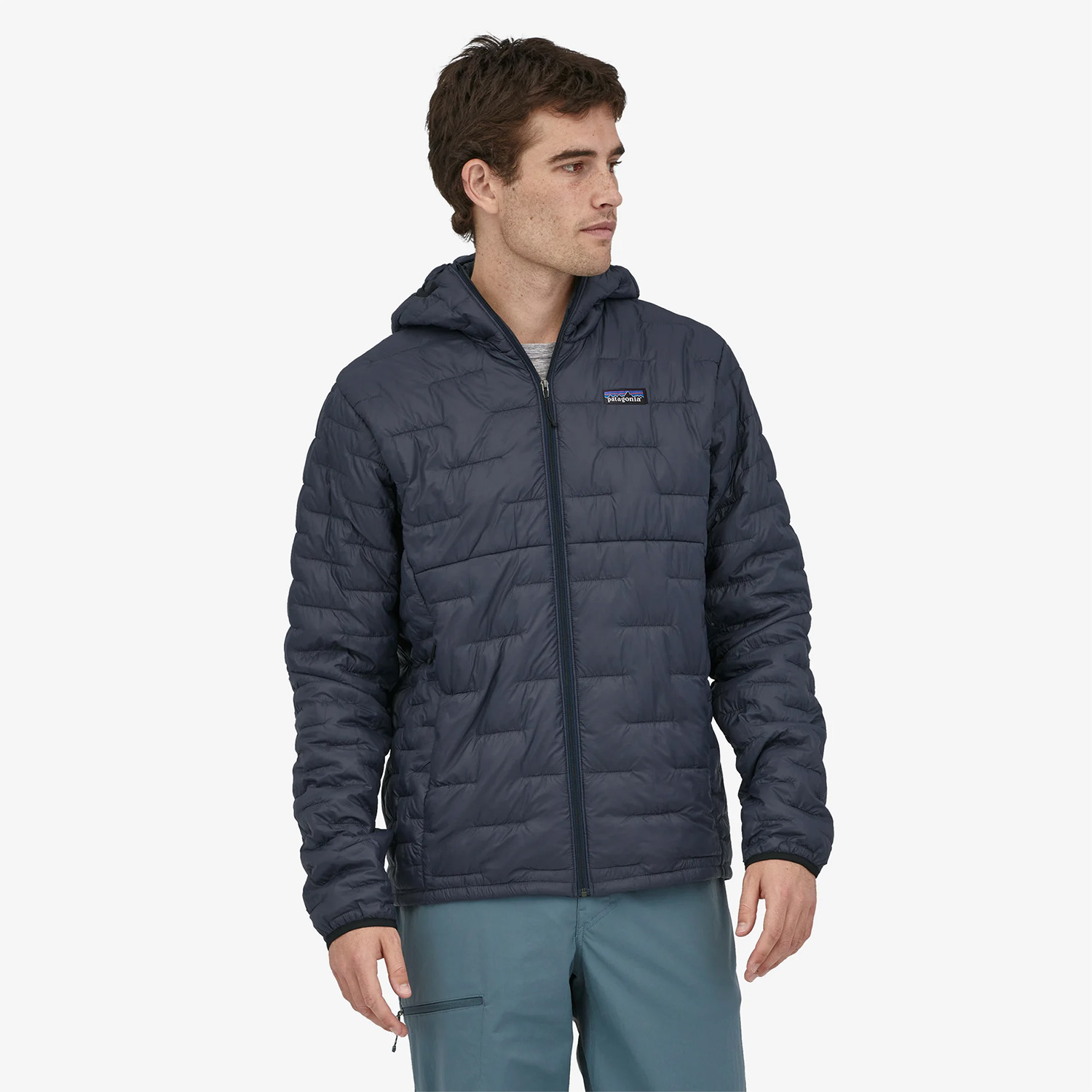
For those reasons, and because it’s a traditional puffy that doesn’t breathe much at all, I use it most often as an insulator that will spend most of its time in my pack, but that I’ll break out during sedentary periods, or if it just gets colder than expected.
In terms of overall warmth, the Micro Puff is warmer than almost all other 60-g synthetic midlayers we’ve used, and is in line with a lot of lightweight down midlayers. It’s no belay parka by any means, but it’s quite warm for this class of “average” midlayers (i.e., not super puffy, but not super thin). It features a very lightweight 10-denier (and fully postconsumer recycled) Pertex Quantum fabric, which has held up well over several years, but it’s definitely a piece that I try to keep from coming into contact with a bunch of rocks, tree branches, etc.
In terms of fit, I’d say the Micro Puff is pretty average for a midlayer — big enough to throw over a slim shell, but trim enough to comfortably layer under most outer layers.
This isn’t a very breathable piece, but it is still remarkable when it comes to warmth-to-weight ratio for a synthetic-insulation midlayer. If you want a slightly more durable and weather-resistant fabric for better capability as an outer layer, see the Patagonia DAS Light Hoody. For a cheaper alternative, see the next piece:
Outdoor Research SuperStrand LT Hoody
MSRP: $219
Fabric: 12D 100% nylon ripstop
Insulation: VerticalX SuperStrand (100% polyester)
Size Tested: Men’s Medium
Reviewer: 5’8”, 155 lbs / 173 cm, 70 kg
Luke Koppa: Up until this year, no synthetic insulation we had used could legitimately compete with Patagonia’s PlumaFill when it came to warmth-to-weight ratio and feeling so similar to down. Outdoor Research’s new VerticalX SuperStrand insulation changed that.
Now, we’re still in the early stages of testing the SuperStrand LT Hoody, but so far it seems like a very strong competitor to the Patagonia Micro Puff Hoody. And once I looked into SuperStrand, that made sense. Most synthetic insulations are constructed in sheets of batted material, like you’d get in a synthetic comforter. But both SuperStrand and PlumaFill consist of continuous polyester fibers that have tons of smaller fibers protruding from them, and visually and physically, the result is something that looks very much like a long string of down fibers. I.e., way fluffier and lower density than batted insulation. I’d wager they’re manufactured in a very, very similar manner.
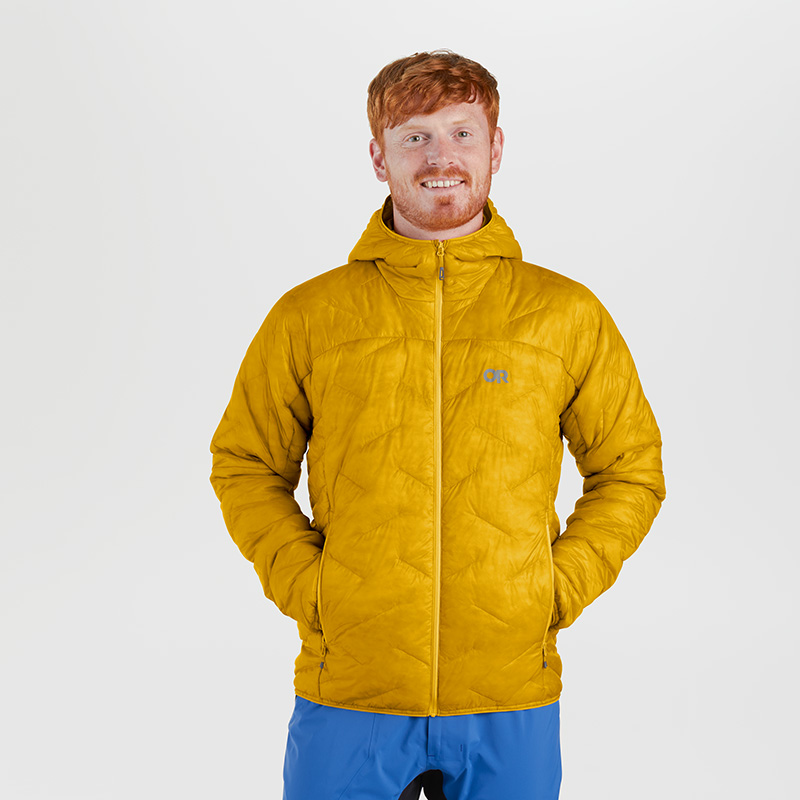
Proprietary tech suspicions aside, the main point is that the SuperStrand LT Hoody feels and performs a heck of a lot like the Micro Puff Hoody. And that’s great — they’re both very light, very packable, and very warm, given those two latter aspects. And they both still insulate pretty well when they’re wet.
They also share nearly identical feature sets: two zippered hand pockets, two drop-in interior pockets, elastic under-helmet hood, and elastic cuffs. The Micro Puff adds a cinchable hem. They fit pretty similarly, too, though the SuperStrand LT Hoody’s sleeves are a bit shorter.
One big difference? The price — the SuperStrand LT is more than $100 less expensive, and is a great alternative to the Micro Puff if you like the sound of lightweight, highly packable synthetic insulation but the Micro Puff’s price tag seems a bit high.
Patagonia DAS Light Hoody
MSRP: $349
Shell Fabric: Pertex Quantum (10D NetPlus 100% postconsumer recycled nylon ripstop)
Lining: Pertex Quantum (10D 100% recycled nylon ripstop)
Insulation: 65-g PlumaFill (100% recycled polyester)
Size Tested: Men’s Medium
Reviewer: 5’8”, 155 lbs / 173 cm, 70 kg
Luke Koppa: As I alluded to above, the DAS Light Hoody is basically a slightly harder-wearing, more weather-resistant, and warmer version of the Micro Puff Hoody. The DAS Light uses the same outer fabric and insulation, but it adds a PU finish and a full hanging lining. The former makes it notably more water resistant and seems to reduce snagging on things like branches, while the latter adds just a touch of warmth and wind resistance.
The DAS Light is also cut a bit roomier than the Micro Puff and comes with more features: an exterior chest pocket and an adjustable, over-the-helmet hood.
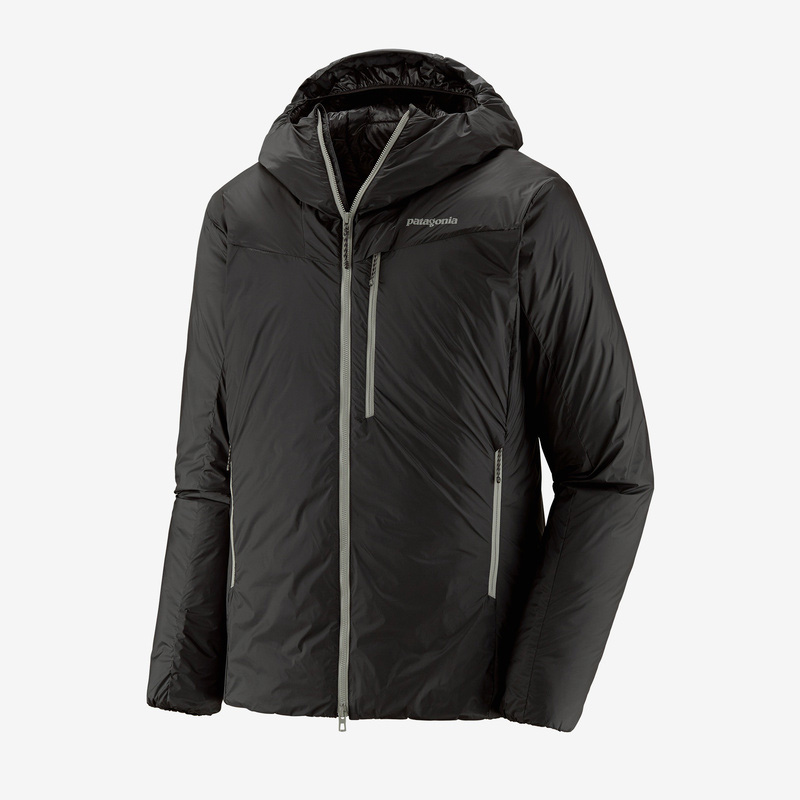
All of this makes the DAS Light a better option than the Micro Puff if you’re looking to frequently use this layer as your outermost jacket. It doesn’t layer quite as well under a shell, but the DAS Light has become one of my go-to insulators to keep in my touring pack and pull out at transitions and often use as my outer jacket on the ski down.
I’ll opt for the much, much bulkier and warmer DAS Parka if I know I’ll be sitting in the cold for extended periods of time, but the DAS Light has been ideal for when I don’t need a full-on belay parka but want a very packable, quite warm, and weather-resistant insulator.
Le Bent Pramecou Wool Insulated Hybrid Jacket
MSRP: $220
Outer Shell: 97% polyester / 3% Spandex
Waffle Panels: 44% polyester / 37% rayon from bamboo / 16% merino wool / 3% Spandex
Inner Lining: 100% nylon
Insulation: 100-g 30% wool / 70% recycled polyester
Size Tested: Men’s Medium
Reviewer: 5’8”, 155 lbs / 173 cm, 70 kg
Luke Koppa: Following years of making baselayers, socks, and accessories, Le Bent got into the midlayer game this year with the introduction of a few different pieces. I’ve been using the Pramecou Wool Insulated Hybrid Jacket for almost a year now, and it’s pretty neat.
As you could guess by the name, this is a hybrid design that utilizes several different materials and fabrics in different areas. Most of the insulation comes from batted 30% wool / 70% recycled polyester across the front torso and upper back.
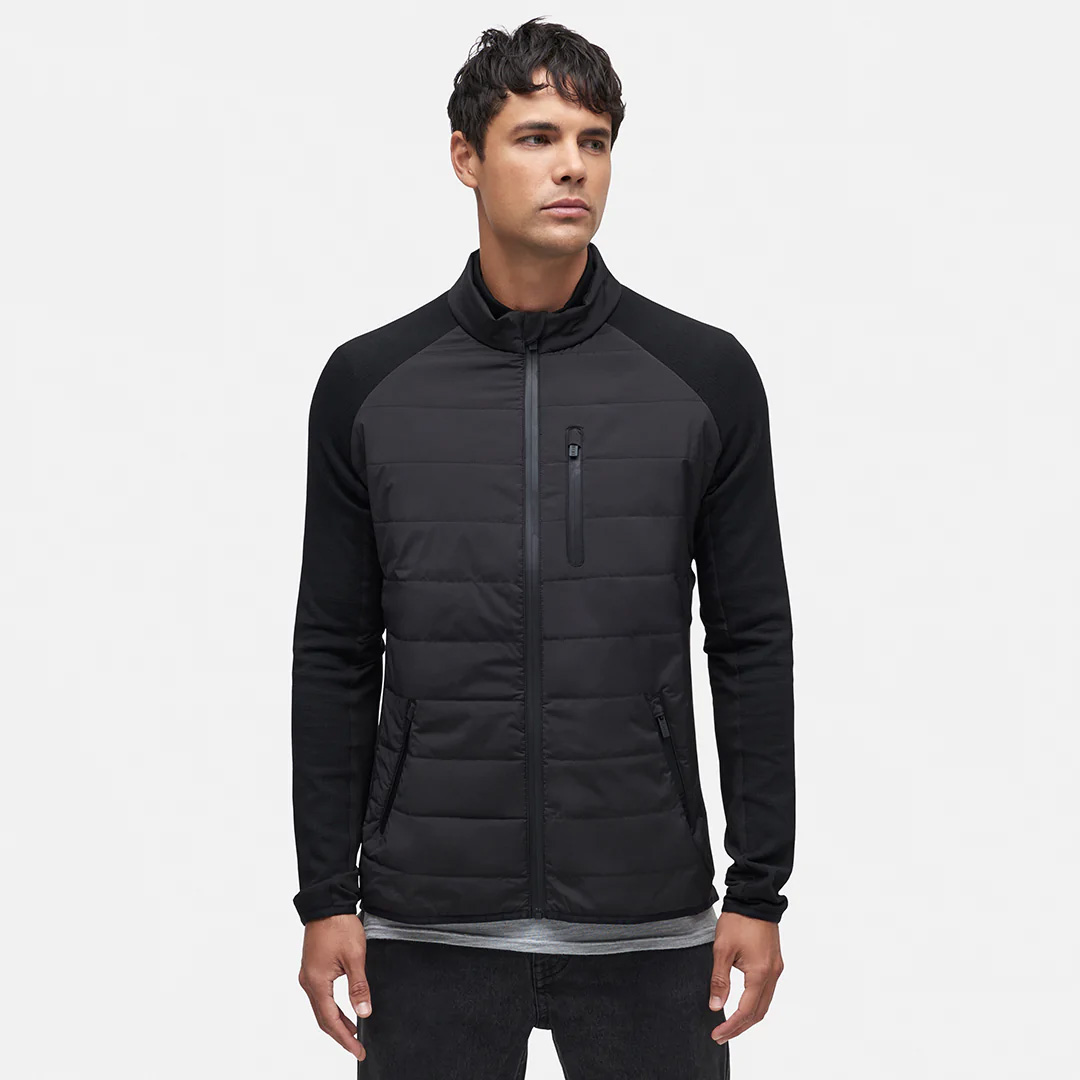
Then there’s a grid fleece that’s a mix of polyester, rayon from bamboo, merino wool, and a bit of Spandex, which covers most of the rest of the garment. Finally, Le Bent added a similar but lighter fabric under the arms and along the sides for added mobility and breathability.
The result is a midlayer that offers excellent range of motion and pretty good breathability, while being similarly warm compared to other active insulators like the Patagonia Nano-Air. It’s become one of my go-to resort-skiing midlayers because of this. When wearing it on its own, the Pramecou Hybrid doesn’t offer as much weather resistance as a traditional puffy insulator, but the torso panel does a good job of blocking wind in that area. The downside is that it doesn’t breathe much at all in that area, which usually isn’t an issue, but is definitely exacerbated when paired with a chest-high pair of bibs.
In terms of fit, the Pramecou Hybrid falls slightly on the slimmer side, though its arm mobility is excellent thanks to its stretchy fabrics and smart patterning. I also think it happens to look very nice. As for features, you get exterior zippered hand pockets and a chest pocket, which I appreciate for stashing my phone.
If you feel caught between puffy and fleece insulation and want a bit of both in one piece, the Pramecou Hybrid is well worth a look.
Strafe Alpha Insulator Short
MSRP: $229
Fabric: Recon AIR lightweight 2-way stretch mini rip-stop | 100% nylon | 20D
Insulation: 80-g Polartec Alpha (100% recycled polyester)
Size Tested: Men’s Large
Reviewer: 5’8”, 155 lbs / 173 cm, 70 kg
Luke Koppa: I was a big fan of Strafe’s original Alpha Direct Insulator jacket, particularly because of how breathable it was, which made it great for cold-weather touring and warm-weather resort skiing. They’ve since updated several of their midlayers, including these shorts.
As you might guess by its name, the Alpha Insulator Short is basically a ¾-length short with a light, soft fabric and 80-g Polartec Alpha insulation. Alpha isn’t the absolute lightest batted insulation but it is one of the most breathable, and paired with Strafe’s Recon AIR fabric, that makes this short extremely comfortable. My legs rarely get very cold — I’m usually fine skiing in just a light baselayer bottom and a shell.
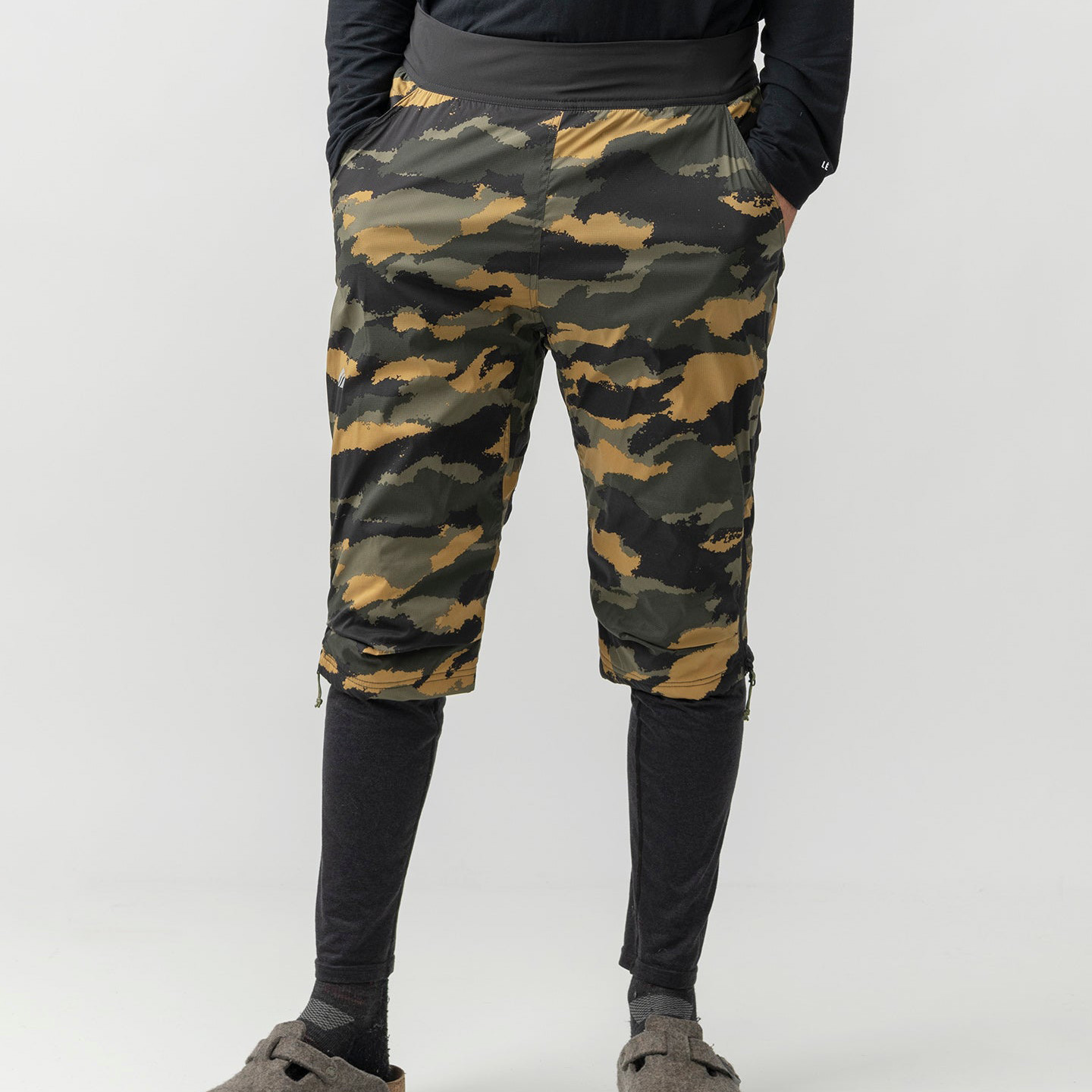

However, we recently had a week of very cold temperatures in Crested Butte, and the Alpha Insulator Short came in really handy when the temperatures weren’t getting into the double digits Fahrenheit (about -17° to -12°C). The short cuts down on the cold of frigid chairlift rides, but the breathable construction kept me from overheating too much on the way down the hill. I don’t think I’ll be breaking out these shorts all that often, but I sure was glad to have them as an option for the coldest days.
Due to limited availability last year, I’ve been using the size Large, which is definitely a bit too big for me, but it seems like it runs pretty true to size (without feeling constricting under a shell). The elastic waistband is comfy and minimizes bulk, though it does mean there’s no way to cinch down the waist if you’ve got too big a size. I appreciate that Strafe still added pockets to the short, including a small zippered one, as well as full side zips for throwing the short over other layers. This is definitely a bit of a niche item, but if your legs frequently get cold and you want a comfy layer that can reduce that while also being great for lounging and that won’t bunch up in your boots, these are pretty sweet.
Patagonia R2 TechFace Jacket
MSRP: $179
Fabric: 7.6-oz stretch double weave (94% polyester; 77% recycled / 6% spandex)
Size Tested: Men’s Medium
Reviewer: 5’8”, 155 lbs / 173 cm, 70 kg
Luke Koppa: We’ve talked at length about Patagonia’s R1 TechFace pieces, which several of our reviewers love as “leave it on all day” layers that add some insulation and weather resistance while breathing far better than most puffy insulators or shells. Following their original “R” naming scheme, the R2 TechFace is very similar, but a bit thicker and warmer.
The R2 TechFace’s fabric is a double weave with a “hard,” tightly woven outer and a gridded, lofted fleece interior. Under a shell, it’s not quite as warm as most of the pieces in this roundup, but it does breathe a whole lot better. As an outer layer, it provides notably more wind and water resistance than traditional fleeces, while still breathing really well.

It’s fit is pretty standard, if not slightly roomier than average for a midlayer. It comes with a pretty usual feature set — one chest pocket, two handwarmer pockets.
The R2 TechFace has become one of my go-to midlayers for resort skiing when the temperatures are hovering around freezing or slightly above, and I’ll also use it (paired with just a baselayer) as my uphill kit for cold touring days.
Artilect M-Intersect Doubleweave Jacket
MSRP: $240
Fabric: double-weave hardface grid fleece
Size Tested: Men’s Medium
Reviewer: 5’8”, 155 lbs / 173 cm, 70 kg
Luke Koppa: Artilect started out primarily with high-end merino baselayers, but they’ve recently branched out into midlayers and outerwear, and I’ve been using their M-Intersect Doubleweave Jacket for the past couple months. Like the Patagonia R2 TechFace, the M-Intersect Doubleweave is a great example of the class of “hardface fleeces” — soft, lofted, gridded interior, but with a substantially tighter, denser, “harder” exterior.
Many of us at Blister have become fans of pieces like this because they’re way more breathable than waterproof shells and still provide some of the warmth of traditional fleeces, but do a much better job of fending off some wind and precipitation than fleeces with more typical knits (and some puffy insulators).
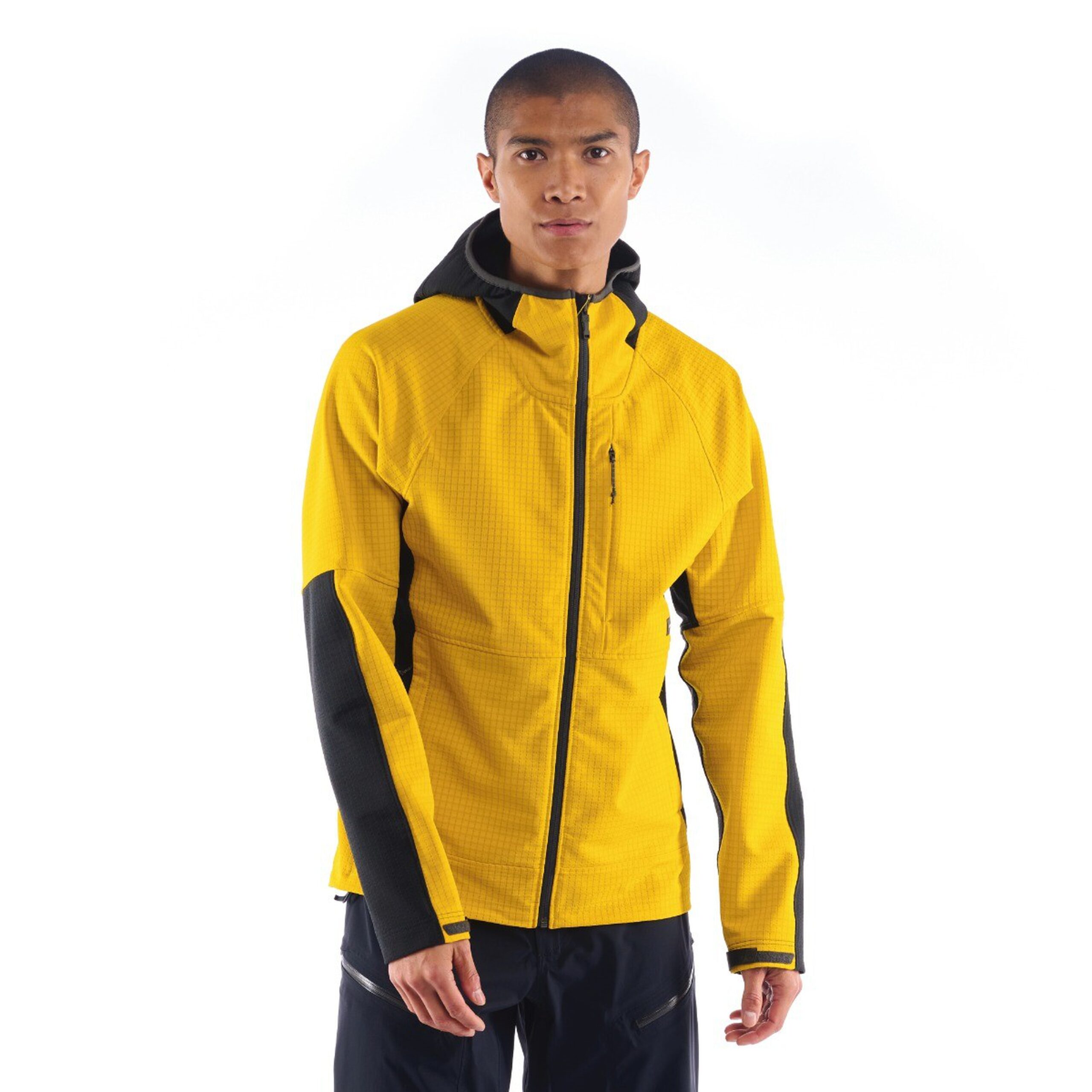
The M-Intersect Doubleweave continues this trend; it’s a great “leave it on” layer for moving relatively high-output activities in cold and variable weather.
The M-Intersect Doubleweave still left me pretty sweaty when working my way up a brutally steep hike in roughly 40°F (4°C) temps, but I definitely would’ve been sweating even more in a windshell or fully waterproof jacket. And in more typical winter conditions, I’ve been comfortable skinning uphill in the M-Intersect Doubleweave with just a baselayer underneath in temps ranging from roughly 20°–30°F (-7 to -1°C). I’m most curious to see how it handles wetter snow and rain, since its fibers feature the new GTT Empel water-repellant treatment, which reportedly bonds the water-repellant monomers to the fibers of the material at the molecular level. The claim is improved water resistance and longevity, with less environmental impact. So far, I haven’t gotten the piece into weather nasty enough to really test the claims (just some fairly dry snow), but I’m optimistic that it’ll at least be able to serve as the outer layer in moderate snow and maybe some light rain.
The Patagonia R2 TechFace is easily the best comparison to the fabric of the M-Intersect Doubleweave; they’re very similar overall, from handfeel to performance. I think the M-Intersect Doubleweave is a touch more weather resistant, while the R2 feels a bit more comfortable / soft on skin and is maybe a touch warmer.
In terms of fit, I’d say the M-Intersect is fairly “regular,” though its arms are nicely long. It gives me plenty of room to toss a midlayer underneath, but it’s not so bulky that I can’t do the opposite and throw the midlayer over during sedentary periods of a day.
Overall, this is a really versatile layer that’s already worked its way into my primary layering setup for touring in winter weather.

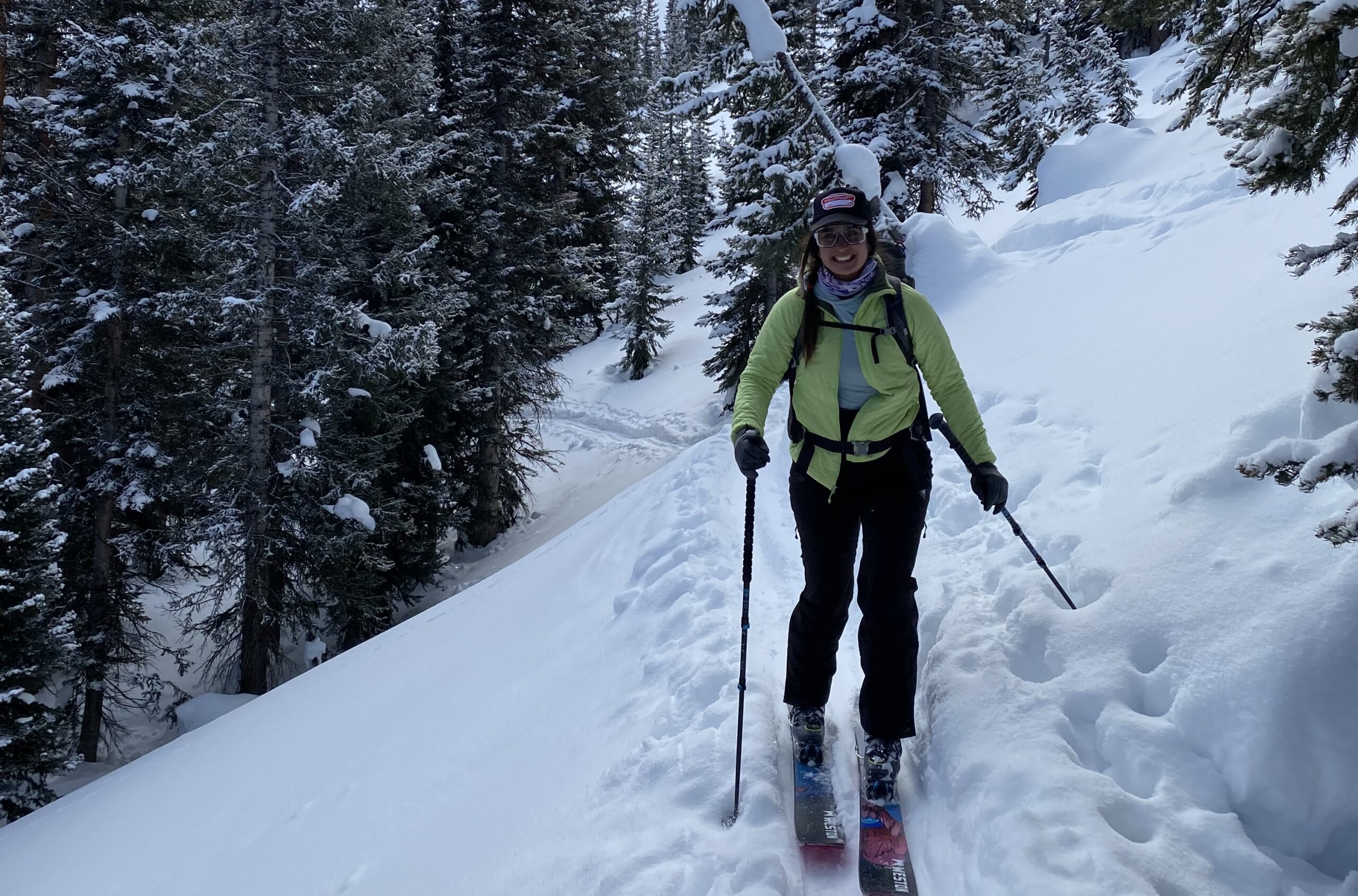


I have a few nano airs and a few atom LTs. I just don’t agree that the nano air doesn’t breathe as well – I think it breathes way better and is the most breathable mid layer of its type. I think the nano air is more comparable to the proton lt.
I do agree the nano air is warmer standing still.
I agree with MD12. I’ve owned and worn both the Nano-Air and the Atom LT for several years To me the Nano is much less wind resistant and hence more breathable. That said, I typically wear the Atom LT when MTB’ing in temps as low as the 20Fs and the Nano when not moving as fast or when I can put a light shell over it.
As I look down this list, it becomes apparent that the definition of “mid-layer” has changed dramatically.
Most of these are simply lightweight jackets (some not even lightweight). I mean, yes, you can put a shell over anything but does that make it a mid-layer?
Good point.
Many of these are specifically designed to offer some level of weather resistance.
This makes sense, as we all know the scenario where you go out with base, mid- and shell layers, get too warm, remove the shell layer, but then wind or light precip picks up, and you get wet/cold from that, but putting the shell back on is too warm.
So, I think they can still be called “mid layers”, but they are a sub calls or hybrid with soft shells. Blister has often classified the thinner ones as that.
I suppose we could call many of these “mid layer+“ garments, because they are an insulation layer designed to be worn under a shell some of the time, but with some weather resistance for the times when you don’t want to do that.
That gives you adjustability in your system. Wear it on its own when less warmth is needed (uphill), and cover it with a shell when more protection from wind or wet is needed (downhill or bad weather).
If we get too fixated on what to categorize something as, we end up not being able to develop the most flexible and functional items and system for us.
Interesting to see the OV Ventus active hoodie make the list – their marketing is so over the top it is hard to tell how good some of their stuff might be. I got sucked into the dragonwool hype during covid lockdown. Its about average but pilled faster than my 100% wool Ibex indie hoodies, so have been hesitant to buy more, but that piece sounds interesting for the weight and if the breathability is real…